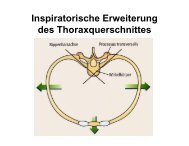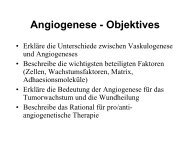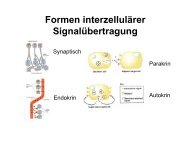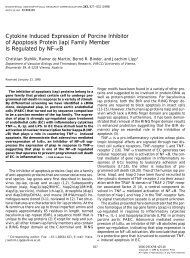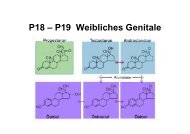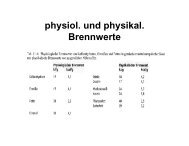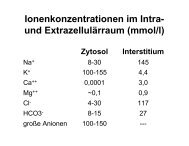Interleukin-33 Induces Expression of Adhesion Molecules and ...
Interleukin-33 Induces Expression of Adhesion Molecules and ...
Interleukin-33 Induces Expression of Adhesion Molecules and ...
Create successful ePaper yourself
Turn your PDF publications into a flip-book with our unique Google optimized e-Paper software.
2086 Arterioscler Thromb Vasc Biol September 2011<br />
Figure 4. <strong>Expression</strong> <strong>of</strong> interleukin (IL)-<strong>33</strong> <strong>and</strong> ST2 in human<br />
atherosclerotic tissue. A, Staining for IL-<strong>33</strong> <strong>and</strong> von Willebr<strong>and</strong><br />
factor or (B, C) staining for IL-<strong>33</strong> <strong>and</strong> ST2 was performed as<br />
described in “Methods.” Original magnification �200 (A) or<br />
�630 (B, C). Representative pictures are shown. Staining was<br />
representative for 3 different donors. D, RNA was isolated from<br />
carotid endartherectomy lesions (n�13) <strong>and</strong> IL-<strong>33</strong> mRNA<br />
<strong>and</strong> ST2 mRNA <strong>and</strong> mRNA for GAPDH was determined by<br />
RealTime-PCR as described in “Methods.” mRNA levels <strong>of</strong> IL-<strong>33</strong><br />
<strong>and</strong> ST2 were correlated after adjustment for GAPDH.<br />
exerted direct proinflammatory properties on human endothelial<br />
cells without a requirement for intermediate autocrine<br />
or juxtacrine action <strong>of</strong> IL-1�, as the natural antagonist<br />
IL-1Ra, which inhibits IL-1� action by preventing its<br />
binding to specific receptors, did not inhibit IL-<strong>33</strong>-induced<br />
upregulation <strong>of</strong> ICAM-1, VCAM-1, E-selectin, or MCP-1<br />
specific mRNA in these cells. We also show that IL-<strong>33</strong><br />
induces nuclear translocation <strong>of</strong> NF-�B p50 <strong>and</strong> p65<br />
subunits in both types <strong>of</strong> endothelial cells suggesting that<br />
the effects <strong>of</strong> IL-<strong>33</strong> are mediated via the NF-�B pathway.<br />
This notion is further supported by our finding that the<br />
stimulatory effect <strong>of</strong> IL-<strong>33</strong> on adhesion molecule <strong>and</strong><br />
MCP-1 expression is abolished by adenoviral overexpression<br />
<strong>of</strong> I�B <strong>and</strong> dnIKK in these cells. In agreement with<br />
our observations, IL-<strong>33</strong> has been shown to activate NF-�B<br />
in various other cell types such as mast cells, 13,20,46<br />
eosinophils, 47 basophils, 18 CD4 � T-cells 48 <strong>and</strong> rat neonatal<br />
cardiac myocytes <strong>and</strong> fibroblasts. 25 Although IL-<strong>33</strong> was<br />
previously shown to activate Erk1/2 <strong>and</strong> Akt pathways, 27,31<br />
MEK inhibitor U0126 or PI3K inhibitor LY-294002 did<br />
not abrogate induction by IL-<strong>33</strong> <strong>of</strong> any <strong>of</strong> the proteins<br />
tested in our study.<br />
Moreover, we found that IL-<strong>33</strong> <strong>and</strong> ST2 are expressed in<br />
human atherosclerotic carotid tissue on both protein <strong>and</strong><br />
mRNA level. Our study is the first that demonstrated expression<br />
<strong>of</strong> both IL-<strong>33</strong> <strong>and</strong> ST2 in human atherosclerotic tissue.<br />
IL-<strong>33</strong> protein is localized to endothelial cells in human<br />
atherosclerotic tissue. It should be emphasized that a previous<br />
study demonstrated increased IL-<strong>33</strong> expression in the atherosclerotic<br />
aorta <strong>of</strong> ApoE �/� mice fed a high-fat diet as<br />
compared to ApoE �/� mice fed a normal diet <strong>and</strong> to<br />
Figure 5. <strong>Interleukin</strong> (IL)-<strong>33</strong> induces a proadhesive <strong>and</strong> proinflammatory<br />
state in explanted atherosclerotic plaque tissue ex<br />
vivo. A–D, F, Fresh carotid endarterectomy samples (n�7) were<br />
incubated with or without IL-<strong>33</strong> at 100 ng/mL for 6 hours <strong>and</strong><br />
(A) intracellularl adhesion molecule-1 (ICAM-1), (B) vascular cell<br />
adhesion molecule-1 (VCAM-1), (C) endothelial selection<br />
(E-selectin), (D) monocyte chemoattractant protein-1 (MCP-1)<br />
<strong>and</strong> (F) IL-6 mRNA was determined by RealTime-PCR as<br />
described in “Methods.” E, G, H, Fresh carotid endarterectomy<br />
samples (n�12) were incubated with or without IL-<strong>33</strong> at 100<br />
ng/mL for 24 hours <strong>and</strong> E, MCP-1, G, IL-6, <strong>and</strong> H, IL-8 protein<br />
in supernatant was measured by specific ELISA as described in<br />
“Methods.” A–H, Individual values <strong>of</strong> the respective protein for<br />
each carotid endarterectomy sample represent the mean value<br />
<strong>of</strong> 3 independent measurements. Box plots show median (bold<br />
black lines), interquartile range (boxes), <strong>and</strong> values within 1.5<br />
interquartile ranges from the upper or lower edge <strong>of</strong> the box<br />
(whiskers). *P�0.05 compared to control.<br />
wild-type mice. 28 Here, we describe that in human atherosclerotic<br />
plaques nuclear IL-<strong>33</strong> <strong>and</strong> membrane-bound ST2<br />
protein are expressed by the same cells, namely by endothelial<br />
cells, <strong>and</strong> that IL-<strong>33</strong> mRNA significantly correlates with<br />
ST2 mRNA expression in carotid atherosclerotic tissue,<br />
suggesting that both proteins are highly coregulated in this<br />
tissue. Furthermore, ex vivo treatment <strong>of</strong> atherosclerotic<br />
tissue samples with IL-<strong>33</strong> increased the expression <strong>of</strong><br />
ICAM-1, VCAM-1, E-selectin, <strong>and</strong> MCP-1 in these tissue<br />
specimens.<br />
Since the discovery <strong>of</strong> IL-<strong>33</strong> in 2005, numerous immunomodulator<br />
effects <strong>of</strong> this cytokine were described in<br />
different cells. IL-<strong>33</strong> enhances adhesion <strong>and</strong> survival <strong>of</strong><br />
Downloaded from<br />
http://atvb.ahajournals.org/ at Bibliothek der MedUniWien (IX0000096057) on September 2, 2011





